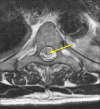Brown-Séquard Syndrome after Thoracic Endovascular Aortic Repair for a Stanford Type B Aortic Dissection
- PMID: 35686522
- PMCID: PMC9188867
- DOI: 10.5758/vsi.220008
Brown-Séquard Syndrome after Thoracic Endovascular Aortic Repair for a Stanford Type B Aortic Dissection
Abstract
We present a case of Brown-Séquard syndrome (BSS) after thoracic endovascular aortic repair (TEVAR) to treat Stanford type B aortic dissection. A 49-year-old male presented to the emergency department with acute tearing pain between the scapulae, connected to respiratory movements. Computed tomography showed Stanford type B aortic dissection from the left subclavian artery to the level of the 11th thoracic vertebra. Conservative treatment was initiated with intravenous antihypertensives. However, due to persistent pain and an increase in the aortic diameter with an intramural hematoma, TEVAR was performed. The patient developed symptoms suspicious of spinal cord ischemia postoperatively. A lesion limited to the left-sided spinal cord was observed on magnetic resonance imaging at the level of the 4th to 5th thoracic vertebra. BSS after TEVAR is a rare phenomenon with a fairly good prognosis, depending on the initial injury severity.
Keywords: Aortic dissection; Endovascular procedures; Spinal cord ischemia; Vascular surgery.
Conflict of interest statement
The authors have nothing to disclose.
Figures



Similar articles
-
In situ laser fenestration during emergent thoracic endovascular aortic repair is an effective method for left subclavian artery revascularization.J Vasc Surg. 2013 Nov;58(5):1171-7. doi: 10.1016/j.jvs.2013.04.045. Epub 2013 Jun 5. J Vasc Surg. 2013. PMID: 23746832
-
Low-density vulnerable thrombus/plaque volume on preoperative computed tomography predicts for spinal cord ischemia after endovascular repair for thoracic aortic aneurysm.J Vasc Surg. 2021 May;73(5):1557-1565.e1. doi: 10.1016/j.jvs.2020.09.026. Epub 2020 Oct 14. J Vasc Surg. 2021. PMID: 33068765
-
Retrograde Ascending Aortic Dissection after Stent Grafting for Stanford Type B Aortic Dissection with Severe Limb Ischemia.Ann Vasc Dis. 2017 Mar 24;10(1):54-58. doi: 10.3400/avd.cr.16-00123. Epub 2017 Mar 31. Ann Vasc Dis. 2017. PMID: 29034023 Free PMC article.
-
Thoracic endovascular aortic repair (TEVAR) in a combined penetrating thoracic aortic and spinal cord injury.J Surg Case Rep. 2024 Dec 21;2025(1):rjae771. doi: 10.1093/jscr/rjae771. eCollection 2025 Jan. J Surg Case Rep. 2024. PMID: 39717414 Free PMC article.
-
Neurological Manifestations of Aortic Dissection: A Scoping Review.J Acute Med. 2024 Dec 1;14(4):135-144. doi: 10.6705/j.jacme.202412_14(4).0001. J Acute Med. 2024. PMID: 39624147 Free PMC article.
Cited by
-
Clinical Outcomes and Safety of Transcatheter Arterial Embolization in Patients with Traumatic or Spontaneous Psoas and Retroperitoneal Hemorrhage.J Clin Med. 2024 Jun 4;13(11):3317. doi: 10.3390/jcm13113317. J Clin Med. 2024. PMID: 38893030 Free PMC article.
References
Publication types
LinkOut - more resources
Full Text Sources

